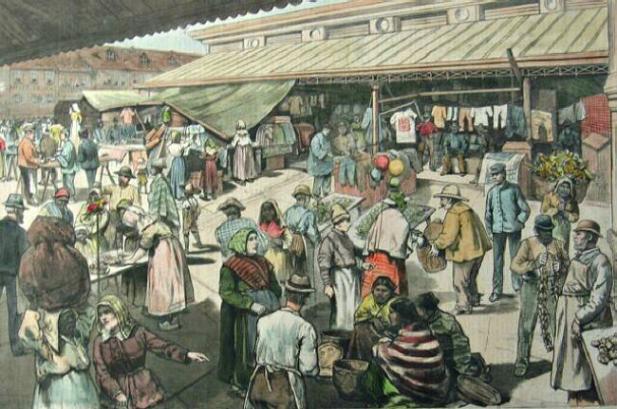| Sunday Morning at the French Market Illustration from Frank Leslie's Newspaper, 1883 Text from The Picayune's Guide to New Orleans, 1903 |
| The link to this page is: http://old-new-orleans.com/NO_Sunday_Morning.html Back to Old New Orleans Whispers - Home |
| French Market: You know it by the busy rush, the noisy rumbling of carts and wheels, the ceaseless clatter of foreign and native tongues, the outlandish garbs, the curious faces, the strange cosmopolitan scene to be nowhere else witnessed on American soil. The market is open daily from 5 a.m. to 12 midnight. The "meat market" was erected in 1813 at a cost of $30,000 and stands on the exact spot where the first market was built in New Orleans in 1723. The best time to visit is early in the morning, and Sunday morning of all others. It is the most remarkable spot in New Orleans. Under its roof, every language is spoken, and this will be noted through its four divisions, the fish, the meat, the vegetable and the fruit market. The buyers and sellers are men and women of all races. Here are the famous coffee stands, where one gets such delicious "cafe noir" or "cafe au lait," with a "brioche" or "cala," as the taste may suggest. There are the Gascon butchers, and the Italian and Spanish fruit vendors, and the German and Italian vegetable women; there are Moors, with their strings of beads and crosses, fresh from the Holy Land; peddlers and tinners and small notion dealers; the "rabais men," with their little stores on wheels; Chinese and Hindu, Jew and Teuton, French and Creole, Spanish and Malay, Irish and English, all uniting in a ceaseless babel of tongues that is simply bewildering. Squatted about the ground between the markets are women with little papooses strapped to their backs or rolled up in shawls and blankets. You catch the odor of wild herbs and woodland leaves, and get a glimpse of the dried sassafras leaves from which the famous "gumbo file" is made. These patient women, with their straight, flowing hair, are the last remnants of the once powerful tribe of Choctaw Indians, who were once the very owners of the soil on which New Orleans stands. They have come all the way from the old Indian settlement of Bayou Lacombe, across Lake Pontchartrain, to the French Market, where they always find a ready sale for their "gumbo file" and bunches of herbs from which the Creoles concoct such fragrant "tisanes." And in the French market, above all, there is the charm of local life and color, especially of a Sunday morning, when the Creole belles and beaux saunter leisurely through, buying roses and jasmines, after hearing a mass in the old Cathedral. -- The Picayune's Guide to New Orleans, 1903 |
